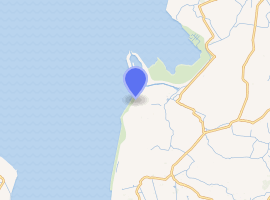Pilsum Lighthouse
The Pilsum Lighthouse (German: Pilsumer Leuchtturm) was built in 1891 in order to provide a beacon for the Emshörn channel on Germany's North Sea coast.[2] It is located on a dyke near the village of Pilsum in the municipality of Krummhörn.[3] It has guided ships through the narrow channel until 1915.[2] In the First World War its light was extinguished so that enemy ships could not navigate the route.[2] After that it was no longer needed, because the channel was changed.[2] The height of the structure is 11 metres;[2] the height of the light about sea level is 15 metres. Today the tower is one of the best-known symbols of East Frisia.[2]
 Pilsum Lighthouse on the dyke | |
 Pilsum Lighthouse Location in Germany | |

| |
| Location | Krummhörn, Germany |
|---|---|
| Coordinates | 53.498013°N 7.045658°E |
| Year first constructed | 1891 |
| Deactivated | 1915–2005[1] |
| Construction | cast iron tower |
| Tower shape | cylinfrical tower with conical roof, no balcony and lantern |
| Markings / pattern | tower with horizontal red and yellow bands, green roof |
| Tower height | 11 metres (36 ft) |
| Characteristic | no available |
| ARLHS number | FED-018 |
| Managing agent | Diechacht Krummhörn |
| Heritage | Kulturdenkmal |
Film
The tower grew in popularity as a result of the film Otto – Der Außerfriesische ("Otto – the Outer Frisian") by comedian Otto Waalkes.[2] In the film Otto lives in the lighthouse. Although the lighthouse is one of the central scenes in Otto – der Außerfriesische, for some reason the picture used on cinema advertisements and later on the inlays of the video and DVD editions was of the Westerheversand Lighthouse, not the Pilsum Lighthouse.
References
- Rowlett, Russ. "Lighthouses of Germany: North Frisia". The Lighthouse Directory. University of North Carolina at Chapel Hill. Retrieved 13 May 2019.
- Scheiblich, Reinhard; Staack, Hans Helge (2010). Leuchttürme Lexikon [Glossary of Lighthouses] (in German). Edition Ellert & Richter. pp. 136–138. ISBN 978-3-8319-0038-1.
- Charles, V. (2015). Lighthouses. Our Earth. Parkstone International. p. 75. ISBN 978-1-78525-732-2. Retrieved 13 May 2019.
External links
- Pilsum Lighthouse (in German)
- Information and photos of Pilsum Lighthouse at www.leuchtturm-welt.de (in German)
| Wikimedia Commons has media related to Pilsum Lighthouse. |
